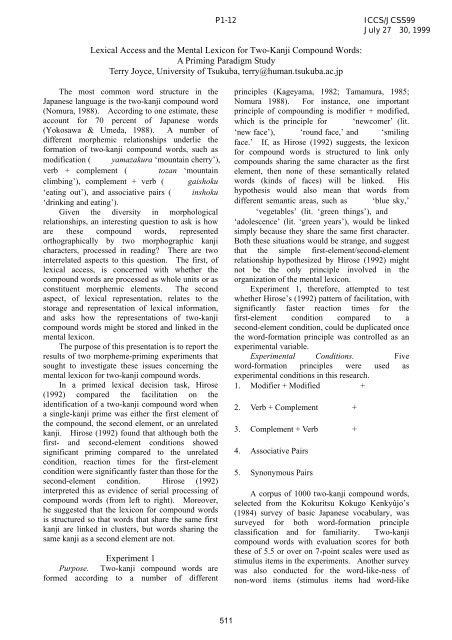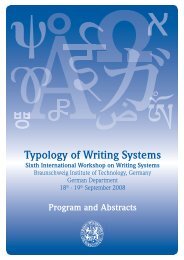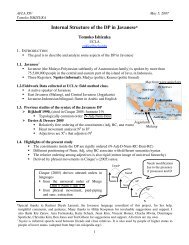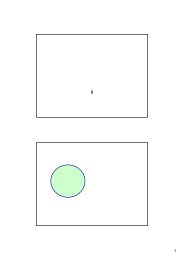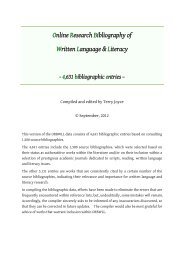A Priming Paradigm Study Terry Joyce, University of Tsukuba
A Priming Paradigm Study Terry Joyce, University of Tsukuba
A Priming Paradigm Study Terry Joyce, University of Tsukuba
Create successful ePaper yourself
Turn your PDF publications into a flip-book with our unique Google optimized e-Paper software.
P1-12 ICCS/JCSS99<br />
July 2730, 1999<br />
Lexical Access and the Mental Lexicon for Two-Kanji Compound Words:<br />
A <strong>Priming</strong> <strong>Paradigm</strong> <strong>Study</strong><br />
<strong>Terry</strong> <strong>Joyce</strong>, <strong>University</strong> <strong>of</strong> <strong>Tsukuba</strong>, terry@human.tsukuba.ac.jp<br />
The most common word structure in the<br />
Japanese language is the two-kanji compound word<br />
(Nomura, 1988). According to one estimate, these<br />
account for 70 percent <strong>of</strong> Japanese words<br />
(Yokosawa & Umeda, 1988). A number <strong>of</strong><br />
different morphemic relationships underlie the<br />
formation <strong>of</strong> two-kanji compound words, such as<br />
modification ( yamazakura ‘mountain cherry’),<br />
verb + complement ( tozan ‘mountain<br />
climbing’), complement + verb ( gaishoku<br />
‘eating out’), and associative pairs ( inshoku<br />
‘drinking and eating’).<br />
Given the diversity in morphological<br />
relationships, an interesting question to ask is how<br />
are these compound words, represented<br />
orthographically by two morphographic kanji<br />
characters, processed in reading? There are two<br />
interrelated aspects to this question. The first, <strong>of</strong><br />
lexical access, is concerned with whether the<br />
compound words are processed as whole units or as<br />
constituent morphemic elements. The second<br />
aspect, <strong>of</strong> lexical representation, relates to the<br />
storage and representation <strong>of</strong> lexical information,<br />
and asks how the representations <strong>of</strong> two-kanji<br />
compound words might be stored and linked in the<br />
mental lexicon.<br />
The purpose <strong>of</strong> this presentation is to report the<br />
results <strong>of</strong> two morpheme-priming experiments that<br />
sought to investigate these issues concerning the<br />
mental lexicon for two-kanji compound words.<br />
In a primed lexical decision task, Hirose<br />
(1992) compared the facilitation on the<br />
identification <strong>of</strong> a two-kanji compound word when<br />
a single-kanji prime was either the first element <strong>of</strong><br />
the compound, the second element, or an unrelated<br />
kanji. Hirose (1992) found that although both the<br />
first- and second-element conditions showed<br />
significant priming compared to the unrelated<br />
condition, reaction times for the first-element<br />
condition were significantly faster than those for the<br />
second-element condition. Hirose (1992)<br />
interpreted this as evidence <strong>of</strong> serial processing <strong>of</strong><br />
compound words (from left to right). Moreover,<br />
he suggested that the lexicon for compound words<br />
is structured so that words that share the same first<br />
kanji are linked in clusters, but words sharing the<br />
same kanji as a second element are not.<br />
Experiment 1<br />
Purpose. Two-kanji compound words are<br />
formed according to a number <strong>of</strong> different<br />
principles (Kageyama, 1982; Tamamura, 1985;<br />
Nomura 1988). For instance, one important<br />
principle <strong>of</strong> compounding is modifier + modified,<br />
which is the principle for ‘newcomer’ (lit.<br />
‘new face’), ‘round face,’ and ‘smiling<br />
face.’ If, as Hirose (1992) suggests, the lexicon<br />
for compound words is structured to link only<br />
compounds sharing the same character as the first<br />
element, then none <strong>of</strong> these semantically related<br />
words (kinds <strong>of</strong> faces) will be linked. His<br />
hypothesis would also mean that words from<br />
different semantic areas, such as ‘blue sky,’<br />
‘vegetables’ (lit. ‘green things’), and <br />
‘adolescence’ (lit. ‘green years’), would be linked<br />
simply because they share the same first character.<br />
Both these situations would be strange, and suggest<br />
that the simple first-element/second-element<br />
relationship hypothesized by Hirose (1992) might<br />
not be the only principle involved in the<br />
organization <strong>of</strong> the mental lexicon.<br />
Experiment 1, therefore, attempted to test<br />
whether Hirose’s (1992) pattern <strong>of</strong> facilitation, with<br />
significantly faster reaction times for the<br />
first-element condition compared to a<br />
second-element condition, could be duplicated once<br />
the word-formation principle was controlled as an<br />
experimental variable.<br />
Experimental Conditions. Five<br />
word-formation principles were used as<br />
experimental conditions in this research.<br />
1. Modifier + Modified + <br />
<br />
2. Verb + Complement + <br />
<br />
3. Complement + Verb + <br />
<br />
4. Associative Pairs <br />
<br />
5. Synonymous Pairs <br />
<br />
A corpus <strong>of</strong> 1000 two-kanji compound words,<br />
selected from the Kokuritsu Kokugo Kenkyûjo’s<br />
(1984) survey <strong>of</strong> basic Japanese vocabulary, was<br />
surveyed for both word-formation principle<br />
classification and for familiarity. Two-kanji<br />
compound words with evaluation scores for both<br />
these <strong>of</strong> 5.5 or over on 7-point scales were used as<br />
stimulus items in the experiments. Another survey<br />
was also conducted for the word-like-ness <strong>of</strong><br />
non-word items (stimulus items had word-like<br />
511
ICCS/JCSS99 P1-12<br />
July 2730, 1999<br />
evaluation scores <strong>of</strong> less than 2.0).<br />
Participants. Forty-two undergraduate and<br />
graduate students <strong>of</strong> the <strong>University</strong> <strong>of</strong> <strong>Tsukuba</strong> took<br />
part in the experiment as volunteers.<br />
Procedure. The procedure for Experiment 1<br />
was similar to that used by Hirose (1992; Exp. 1).<br />
After a fixation point (1000 ms), the single-kanji<br />
prime was presented for 1000 ms. Then, after a<br />
blank (500 ms), fixation points for the target (1000<br />
ms) and another blank (500 ms), a two-kanji<br />
compound target word was displayed. The target<br />
was displayed until the participant made a lexical<br />
decision by pressing a key on a response box.<br />
Results. The results from Experiment 1 (and<br />
Experiment 2) are shown in the table below. As<br />
the overall error rate was very low (4.57% for 3780<br />
responses), the focus <strong>of</strong> analysis was on the reaction<br />
time results.<br />
Repeated measures ANOVAs for reaction<br />
times indicated a significant main effect <strong>of</strong><br />
prime–target relation (F s (2, 82) = 104.42, p < 0.01;<br />
F i (2, 170) = 54.71, p < 0.01). Post-hoc analysis<br />
indicated that in all word formation principle<br />
conditions, the reaction times for the first-element<br />
and the second-element conditions were<br />
significantly faster than for the unrelated conditions.<br />
However, reaction times in the first-element<br />
conditions and second-element conditions were not<br />
significantly different from each other. The results<br />
for word-formation principle over the prime–target<br />
conditions indicated that there were no significant<br />
differences at the 0.05 level.<br />
Thus, the pattern <strong>of</strong> priming found in Hirose<br />
(1992) was not obtained in this experiment.<br />
Experiment 2<br />
Purpose. The SOA <strong>of</strong> 3000ms used by<br />
Hirose (1992) is very long. It may, therefore, be<br />
possible that the participants had time to adopt<br />
strategies in making their lexical decisions.<br />
Therefore, Experiment 2 sought to test whether the<br />
pattern <strong>of</strong> priming found in Experiment 1 could still<br />
be obtained with a short SOA <strong>of</strong> 250 ms, at a level<br />
<strong>of</strong> automatic priming (Neely, 1977, 1991).<br />
Participants. Forty-five undergraduate<br />
students <strong>of</strong> the <strong>University</strong> <strong>of</strong> <strong>Tsukuba</strong> took part in<br />
the experiment as volunteers.<br />
Procedure. A plus symbol for 250 ms,<br />
prime for 200 ms, and a symbol as mask to<br />
the single-kanji prime for 50 ms appeared one<br />
after the other.<br />
Mean Reaction Times (RT) (in milliseconds), Reaction Time Differences (RT Diff) and Error Rates<br />
(ER) (as percentages) as a Function <strong>of</strong> Word-Formation Principle and Prime–Target Relationship<br />
in Experiment 1 and Experiment 2<br />
Experiment 1 Experiment 2<br />
Word Formation Principle RT RT Diff ER RT RT Diff ER<br />
Modifier + Modified<br />
First Element 531 +60 0.39 539 +61 1.66<br />
Second Element 548 +43 1.58 550 +50 2.14<br />
Unrelated 591 5.55 600 3.57<br />
Verb + Complement<br />
First Element 542 +66 1.98 544 +76 2.66<br />
Second Element 559 +49 3.17 566 +54 2.00<br />
Unrelated 608 11.50 620 5.33<br />
Complement + Verb<br />
First Element 569 +45 3.96 564 +65 3.95<br />
Second Element 556 +58 2.77 561 +68 2.22<br />
Unrelated 614 9.12 629 6.91<br />
Associative Pairs<br />
First Element 547 +62 3.17 550 +72 2.98<br />
Second Element 542 +67 1.98 558 +64 2.22<br />
Unrelated 609 6.74 622 6.89<br />
Synonymous Pairs<br />
First Element 545 +68 3.96 531 +97 1.77<br />
Second Element 536 +77 1.58 536 +92 0.67<br />
Unrelated 613 8.73 628 6.00<br />
512
P1-12 ICCS/JCSS99<br />
July 2730, 1999<br />
These were followed immediately by the target,<br />
which remained on the screen until the lexical<br />
decision was made.<br />
Results. The overall error rate was also low<br />
(3.82% for 6480 responses) in Experiment 2, and<br />
thus emphasis was again given to the analysis <strong>of</strong><br />
reaction times.<br />
Repeated measures ANOVAs for reaction<br />
times indicated a significant main effect <strong>of</strong><br />
prime–target relation (F s (2, 88) = 146.45, p < 0.01;<br />
F i (2, 138) = 156.64, p < 0.01). Post-hoc analysis<br />
indicated that reaction times in both the<br />
first-element condition and the second-element<br />
condition were significantly faster than the<br />
unrelated condition. Although there was a<br />
significant difference in favour <strong>of</strong> the first-element<br />
in the verb + complement condition, no significant<br />
differences between the reaction times in the firstand<br />
the second-element conditions were found in<br />
the other word-formation principles. The results<br />
for word formation principle over the prime–target<br />
conditions indicated that there were no significant<br />
differences at the 0.05 level.<br />
Thus, the results <strong>of</strong> Experiment 2 confirm the<br />
basic pattern <strong>of</strong> priming found in Experiment 1.<br />
This indicates that the priming found in Experiment<br />
1 was not the result <strong>of</strong> strategy-adoption by the<br />
participants.<br />
General Discussion<br />
Overall, these experiments provide very little<br />
evidence for significant differences between the<br />
first-element condition and the second-element<br />
condition. Thus, they do not support Hirose’s<br />
(1992) suggestions that compound words are<br />
structured in the mental lexicon centered on the first<br />
element, and that processing <strong>of</strong> compound words is<br />
serial from left to right.<br />
The lack <strong>of</strong> significant differences between the<br />
first and second element also provides little<br />
evidence for influence <strong>of</strong> word formation principle<br />
in terms <strong>of</strong> averaged reaction times. Although<br />
there does appear to be a slight tendency in the data<br />
for differences in the pattern <strong>of</strong> priming from the<br />
first- and second-element conditions for both<br />
modifier + modified and verb + complement<br />
principles compared to the other principles, these<br />
differences were non-significant in almost all cases.<br />
The finding from these experiments, then, is<br />
that both related prime conditions facilitate<br />
responses to the target at similar levels, which<br />
suggests that both morphemic elements <strong>of</strong> a<br />
compound word contribute to lexical access. This<br />
finding is more consistent with a multilevel<br />
interactive-activation model, such as that proposed<br />
by Taft and others (Taft, Liu, & Zhu, 1999; Taft &<br />
Zhu, 1995, 1997a, 1997b) for Chinese word<br />
recognition.<br />
In developing this model, Taft and Zhu have<br />
argued that above the feature-level representations<br />
corresponding to the strokes <strong>of</strong> Chinese characters<br />
there are sub-lexical level representations for<br />
radicals (both semantic and phonetic markers)<br />
(1997a), and that above these there are<br />
Chinese-character, or morpheme level,<br />
representations (1995, 1997b). Although, these<br />
earlier versions <strong>of</strong> the model also included<br />
two-character (poly-morphemic) word level<br />
representations, in an important modification to the<br />
model Taft, Liu and Zhu (1999) have recently<br />
proposed the inclusion <strong>of</strong> lemma units, abstract<br />
modality-free units, mediating the links between<br />
orthographic, phonological, and semantic units.<br />
Similar to the concept nodes in the model <strong>of</strong><br />
morphological processing proposed by Schreuder<br />
and Baayen (1995), these lemma units have the<br />
advantages <strong>of</strong> eliminating the representational<br />
redundancy <strong>of</strong> the previous versions, solving the<br />
problem <strong>of</strong> homographs, and providing an effective<br />
way to capture varying degrees <strong>of</strong> semantic<br />
transparency between polymorphemic words.<br />
These advantages <strong>of</strong> the lemma unit version <strong>of</strong><br />
the model would also be available when adapting<br />
the framework to account for the Japanese mental<br />
lexicon, for all the representational levels in this<br />
hierarchical structure are relevant to Japanese. In<br />
the case <strong>of</strong> a Japanese version <strong>of</strong> the multilevel<br />
interactive-activation model, these lemma units<br />
provide another extremely important advantage.<br />
For they also <strong>of</strong>fer a very promising approach to<br />
modeling the complex relationships between<br />
meaning, orthography and phonology that arise<br />
from the Japanese writing system’s multi-script<br />
nature and its dual-reading system. As shown in<br />
the figure on the next page, these lemma units can<br />
mediate the connections between semantic units and<br />
the access representation units. In the case <strong>of</strong><br />
orthographic units, these would include both kanji<br />
and kana, and in the case <strong>of</strong> phonological units,<br />
there are both on- and kun-readings. When more<br />
than one unit at the same level link to a unit at<br />
another level, it is necessary to specify the order <strong>of</strong><br />
the links (Taft, Liu & Zhu, 1999). Although, in<br />
the figure, this is indicated by numbers on the<br />
relevant connections, this should rather be seen as<br />
part <strong>of</strong> the lemma units themselves. These are<br />
assumed to involve mechanisms <strong>of</strong> licensing and<br />
composition (Schreuder & Baayen, 1995),<br />
employing syntactic, semantic and morphological<br />
information, such as that which underlies<br />
word-formation.<br />
513
ICCS/JCSS99 P1-12<br />
July 2730, 1999<br />
semantic units<br />
cherry<br />
mountain<br />
cherry<br />
mountain<br />
mountain<br />
climbing<br />
climb<br />
nominal<br />
ending<br />
base<br />
ending<br />
lemma units<br />
<br />
<br />
<br />
2<br />
<br />
2<br />
<br />
1<br />
1<br />
<br />
<br />
2<br />
2<br />
1<br />
1 1 1<br />
2<br />
<br />
2<br />
1<br />
1<br />
3<br />
2<br />
1<br />
1<br />
2<br />
1<br />
2<br />
3<br />
2<br />
2<br />
2<br />
1<br />
1<br />
1<br />
1<br />
to<br />
ru<br />
nob<br />
2<br />
san (zan)<br />
yama<br />
sakura (zakura)<br />
orthographic units<br />
<br />
<br />
ri<br />
phonological units<br />
Lemma Unit Connections in Multilevel Interactive-Activation Model for Japanese<br />
References<br />
Hirose, H. (1992). Jukugo no nichi katei ni kan suru<br />
kenkyû: Puraimingu hô ni yoru kentô [An<br />
investigation <strong>of</strong> the recognition process for<br />
jukugo by use <strong>of</strong> priming paradigms].<br />
Shinrigaku Kenkyû, 63, 303-309.<br />
Kageyama, T. (1982). Word formation in Japanese.<br />
Lingua, 57, 215-258.<br />
Kokuritsu Kokugo Kenkyûjo. (1984). Nihongo<br />
kyôiku no tame no kihon goi chôsa [A study <strong>of</strong><br />
the fundamental vocabulary for Japanese<br />
language teaching: General description and<br />
vocabulary tables]. (Research report 78). Tokyo:<br />
Shuei Shuppan.<br />
Neely, J. H. (1977). Semantic priming and retrieval<br />
from lexical memory: Roles <strong>of</strong> inhibitionless<br />
spreading activation and limited-capacity<br />
attention. Journal <strong>of</strong> Experimental Psychology:<br />
General, 106, 226-254.<br />
Neely, J. H. (1991). Semantic priming effects in<br />
visual word recognition: A selective review <strong>of</strong><br />
current findings and theories. In D. Besner, & G.<br />
W. Humphreys, (Eds.), Basic processes in<br />
reading: Visual word recognition (pp. 264-336).<br />
Hillsdale, NJ: Lawrence Erlbaum Associates.<br />
Nomura, M. (1988). Niji kango no kôzô [The<br />
structure <strong>of</strong> 2 kanji Sino-Japanese words].<br />
Nihongogaku, 7(5), 44-55.<br />
Schreuder, R., & Baayen, R. H. (1995). Modeling<br />
morphological processing. In L. B. Feldman,<br />
(Ed.), Morphological aspects <strong>of</strong> language<br />
processing (pp. 131-154). Hillsdale, NJ:<br />
Lawrence Erlbaum Associates.<br />
Taft, M., Liu, Y., & Zhu, X. (1999). Morphemic<br />
processing in reading Chinese. In J. Wang, A.<br />
Inh<strong>of</strong>f, & H.-C. Chen, (Eds.), Reading Chinese<br />
script: A cognitive analysis (pp. 91-113).<br />
Hillsdale, NJ: Lawrence Erlbaum Associates.<br />
Taft, M., & Zhu, X. (1995). The representation <strong>of</strong><br />
bound morphemes in the lexicon: A Chinese<br />
study. In L. B. Feldman, (Ed.), Morphological<br />
aspects <strong>of</strong> language processing (pp. 293-316).<br />
Hove, England: Lawrence Erlbaum Associates.<br />
Taft, M., & Zhu, X. (1997a). Submorphemic<br />
processing in reading Chinese. Journal <strong>of</strong><br />
Experimental Psychology: Learning, Memory<br />
and Cognition, 23, 761-775.<br />
Taft, M., & Zhu, X. (1997b). Using masked priming<br />
to examine lexical storage <strong>of</strong> Chinese<br />
compound words. In H.-C. Chen (Ed.),<br />
Cognitive Processing <strong>of</strong> Chinese and Related<br />
Asian Languages (p. 233-241). Shatin, Hong<br />
Kong: The Chinese <strong>University</strong> Press.<br />
Tamamura, F. (1985). Go no kôsei to zôgohô [The<br />
structure <strong>of</strong> words and principles <strong>of</strong> word<br />
formation] In Kokuritsu Kokugo Kenkyûjo. Go<br />
no kenkyû to kyôiku (shita) Nihongo kyôiku<br />
shidô sankôsho 13 (pp. 1-78). Tokyo: Ôkurashô<br />
Insatsukyoku.<br />
Yokosawa, K., & Umeda, M. (1988). Processes in<br />
human kanji-word recognition. Proceedings <strong>of</strong><br />
the 1988 IEEE international conference on<br />
systems, man, and cybernetics (pp. 377-380).<br />
August 8-12, 1988, Beijing and Shenyang,<br />
China.<br />
514


